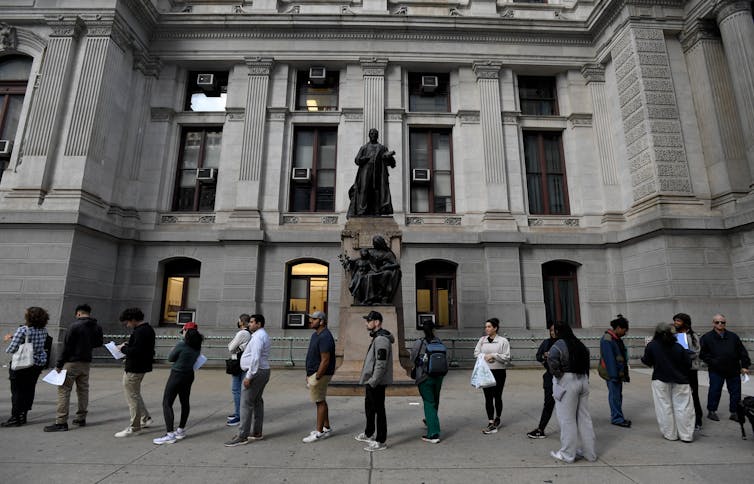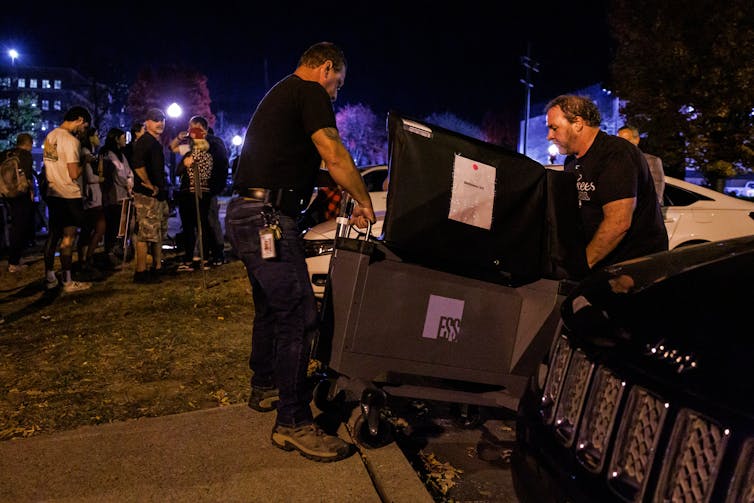How Trump won Pennsylvania − and what the numbers from key counties show about the future of a pivotal swing state
- Written by Daniel J. Mallinson, Associate Professor of Public Policy and Administration, Penn State
 People gather at McGillin's Olde Ale House in Philadelphia as election results trickle in. Ed Jones/AFP via Getty Images
People gather at McGillin's Olde Ale House in Philadelphia as election results trickle in. Ed Jones/AFP via Getty ImagesPennsylvania was for months considered the key swing state that would decide the 2024 election. Candidates, political parties and advocacy groups spent over US$1 billion courting the commonwealth’s small number of persuadable voters.
We now know that former – and now future – President Donald Trump carried the state by the largest margin of the past three presidential elections. He won in 2016 by 0.72%, and Biden won in 2020 by 1.2%. Two days after Election Day, Trump has a 2% lead on Harris.
I’m an associate professor of public policy and administration at Penn State Harrisburg and a lifelong Pennsylvanian.
Here’s how Trump won Pennsylvania, and what the votes cast in some of the state’s key counties tell us about the present and future of American politics.
Important caveat: This is all based on numbers current as of Thursday, Nov. 7, 2024, and before the final tallies.
Philadelphia
The big story of the night for me was voter turnout in Philadelphia.
Turnout in Pennsylvania’s largest city has long been viewed as critical for statewide Democratic victories.
It looks like the city’s turnout in 2024 will be on par with 2016, when political analysts blamed low Philly turnout for Hillary Clinton losing the “blue wall” state of Pennsylvania. Roughly 700,000 Philadelphians voted in 2016, compared with about 708,000 in 2024. Both are smaller than the 750,000 that turned out in Philly in 2020, which helped Joe Biden secure his win.
Not only that, but the Trump campaign was also successful in narrowing the margin of victory for Democratic candidate Kamala Harris in Philly by 2%. So not only did fewer voters turn out in 2024 in Philly, but Trump was able to pick up a few thousand more votes in the city than he did in 2020.
 Philadelphia residents line up to cast their ballots on the last day of early voting, Oct. 29, 2024.Matthew Hatcher/AFP via Getty Images
Philadelphia residents line up to cast their ballots on the last day of early voting, Oct. 29, 2024.Matthew Hatcher/AFP via Getty ImagesThe bellwethers
Erie County in the northwest corner of the state has been the quintessential bellwether in Pennsylvania since the 1980s. In recent elections, it went for Barack Obama in 2008 and 2012, Trump in 2016 and Biden in 2020. It held onto its title in 2024 by going for Trump.
Across the past 25 statewide elections – for governor, U.S. senator, attorney general and so on – Erie has voted for the winner in 23, or 90%, of those races.
Erie is a deeply blue-collar county that is whiter and poorer than both the commonwealth and the country overall. Like Pennsylvania more broadly, Erie County traditionally had a strong Democratic registration advantage, but that declined by 18% from 2020 to 2024.
A question for the future will be whether Bucks County in southeastern Pennsylvania becomes another bellwether.
Republicans were able to achieve a narrow voter registration advantage in this county bordering Philadelphia in 2024, flipping it from blue to red for the first time since 2007.
That advantage held in the final vote count, while the other collar counties – Delaware, Montgomery and Chester – remain solidly Democratic. Importantly for Harris, though, even her margins in these blue counties declined from Biden’s in 2020.
Like Erie, Bucks extends from more densely populated areas, just north of Philadelphia, through suburbs and into rural areas. Although Bucks is a much larger county than Erie in terms of population, it has a similar racial and ethnic makeup. However, it also is home to more college graduates, which has become a key marker of the partisan divide.
 Workers deliver an additional voting machine to a polling location in Bethlehem, Pa.Samuel Corum/AFP via Getty Images
Workers deliver an additional voting machine to a polling location in Bethlehem, Pa.Samuel Corum/AFP via Getty ImagesA tale of 2 steel towns
Cambria and Northampton counties in western and eastern Pennsylvania, respectively, tell contrasting tales of what has happened to Rust Belt counties in the state, including their attraction to Trump.
Northampton is home to the city of Bethlehem, which was the headquarters of Bethlehem Steel, the American steelmaking behemoth founded in 1857. Cambria, meanwhile, was the headquarters for the Cambria Iron Co., which was later sold to Bethlehem Steel.
Needless to say, both were industrialized union towns, with solid blocs of Democratic voters throughout the decades, and both were devastated by globalization that closed Bethlehem Steel in 2003. But their futures diverged economically and politically.
Northampton lies near the economically powerful I-95 corridor and now has the fastest-growing economy in Pennsylvania, owing to new manufacturing of medical devices, guitars and semiconductors, as well as jobs in health care and Amazon’s distribution network.
While Cambria has grown its health care and education sectors, the county lags economically. Politically, Cambria has firmly embraced Trump, whereas Northampton is narrowly divided.
Still, Trump carried both counties in ways that are telling for this election.
Cambria is a deeply red county in western Pennsylvania populated by Trump’s traditional white, working-class, non-college-educated supporters. Republican vote share has been increasing in the county since the late 1980s but accelerated dramatically during the first two Trump elections. Because of Election Day problems with vote-reading machines that resulted in a hand count, Cambria’s results are still not settled. But there is no doubt the county will once again support Trump.
Northampton County is far more racially and ethnically diverse, with 16% of residents identifying as Hispanic/Latino. Early returns show Trump winning Northampton by 2%, whereas Biden won it by 0.8% in 2020. Neighboring Bucks, Lehigh, Monroe and Lackawanna counties also moved 2% to 3% in Trump’s direction. This reflects Trump’s notable gain with Latino voters in this election nationwide.
 A Trump rally in Johnstown, the largest city in Cambria County.Justin Merriman via Getty Images
A Trump rally in Johnstown, the largest city in Cambria County.Justin Merriman via Getty ImagesThe future
It will take months to fully unpack the results of this election.
It remains to be seen whether this was simply an anti-incumbent election and Harris could not outrun dissatisfaction with the current administration, or if durable shifts have occurred in Pennsylvania’s electorate.
Donald Trump will not be on the ballot in 2028, and candidates running in the MAGA lane have not performed as well in recent years as he has in the commonwealth and elsewhere.
I believe Pennsylvania will remain a swing state in 2028. But Democrats will need a more compelling message, not just for the white working class, but also for working-class Latinos and African Americans in these key counties.
Daniel J. Mallinson does not work for, consult, own shares in or receive funding from any company or organization that would benefit from this article, and has disclosed no relevant affiliations beyond their academic appointment.
Authors: Daniel J. Mallinson, Associate Professor of Public Policy and Administration, Penn State

